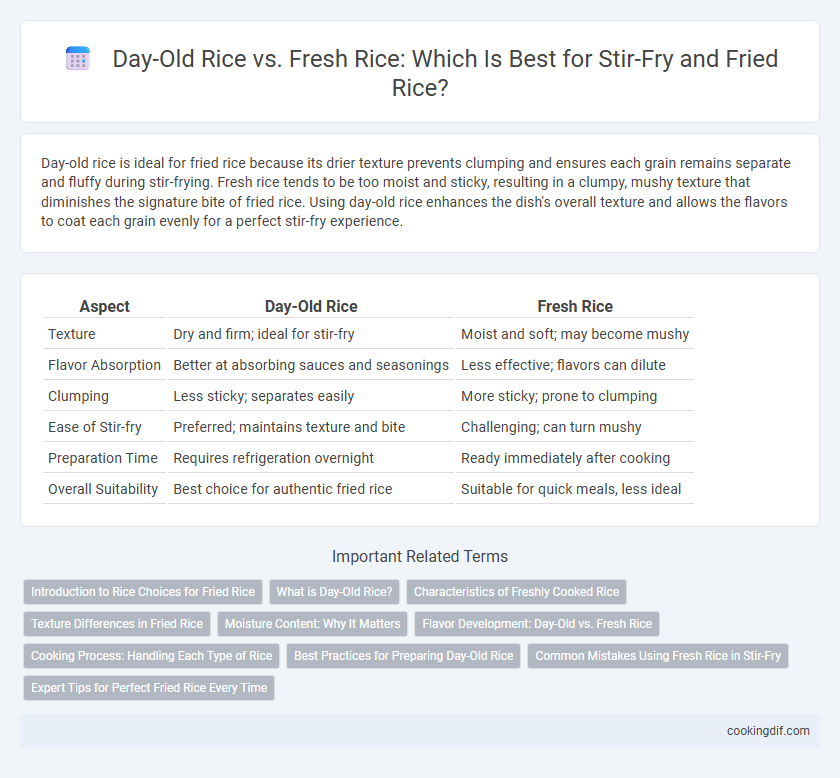Day-old rice is ideal for fried rice because its drier texture prevents clumping and ensures each grain remains separate and fluffy during stir-frying. Fresh rice tends to be too moist and sticky, resulting in a clumpy, mushy texture that diminishes the signature bite of fried rice. Using day-old rice enhances the dish's overall texture and allows the flavors to coat each grain evenly for a perfect stir-fry experience.
Table of Comparison
| Aspect | Day-Old Rice | Fresh Rice |
|---|---|---|
| Texture | Dry and firm; ideal for stir-fry | Moist and soft; may become mushy |
| Flavor Absorption | Better at absorbing sauces and seasonings | Less effective; flavors can dilute |
| Clumping | Less sticky; separates easily | More sticky; prone to clumping |
| Ease of Stir-fry | Preferred; maintains texture and bite | Challenging; can turn mushy |
| Preparation Time | Requires refrigeration overnight | Ready immediately after cooking |
| Overall Suitability | Best choice for authentic fried rice | Suitable for quick meals, less ideal |
Introduction to Rice Choices for Fried Rice
Day-old rice is preferred for fried rice due to its reduced moisture content, allowing grains to separate easily and absorb flavors without becoming mushy. Fresh rice tends to be more moist and sticky, which can cause clumping and a less desirable texture in stir-fried dishes. Choosing the right rice, typically medium or long-grain varieties, ensures optimal absorbency and a perfect balance of chewiness and firmness in fried rice.
What is Day-Old Rice?
Day-old rice refers to cooked rice that has been refrigerated for at least 24 hours, allowing it to dry out and firm up. This drying process reduces moisture content, preventing clumping and excess water release during stir-frying, which results in a better texture for fried rice. Using day-old rice ensures individual grains stay separate and absorb flavors more effectively compared to freshly cooked rice.
Characteristics of Freshly Cooked Rice
Freshly cooked rice for stir-fry tends to be moist and soft with grains that stick together, making it less ideal for achieving the desired separation in fried rice. Its higher moisture content causes clumping and a mushy texture when stir-fried, reducing the dish's overall quality. Optimal fried rice typically requires drier, firmer grains found in day-old rice, which help maintain a fluffy, distinct grain structure.
Texture Differences in Fried Rice
Day-old rice has a drier, firmer texture ideal for stir-fry as it prevents clumping and sogginess, allowing each grain to remain distinct and absorb flavors better. Fresh rice contains more moisture, resulting in a softer, stickier texture that can cause fried rice to become mushy and less flavorful. For optimal texture in fried rice, day-old rice ensures a balanced chewiness and crispness, enhancing the overall eating experience.
Moisture Content: Why It Matters
Day-old rice contains less moisture compared to fresh rice, making it ideal for stir-fried dishes as it prevents clumping and sogginess. Lower moisture content allows each grain to separate easily, resulting in a lighter, fluffier texture that absorbs flavors better. Using day-old rice ensures a superior fried rice experience with enhanced taste and texture.
Flavor Development: Day-Old vs. Fresh Rice
Day-old rice enhances fried rice flavor development due to its reduced moisture content, allowing the grains to separate and absorb seasonings more effectively. Fresh rice tends to be too soft and sticky, which can result in clumping and a less distinct texture in stir-fry dishes. Using day-old rice ensures a more balanced, flavorful, and texturally appealing fried rice experience.
Cooking Process: Handling Each Type of Rice
Day-old rice is preferred for fried rice due to its drier texture, which prevents clumping and ensures each grain remains separate during stir-frying. Fresh rice contains higher moisture content, requiring careful cooking adjustments such as spreading it out to evaporate excess steam and prevent sogginess. Properly handling day-old rice involves breaking up clumps before cooking, while fresh rice benefits from slightly undercooking and rapid cooling to achieve optimal stir-fry texture.
Best Practices for Preparing Day-Old Rice
Day-old rice is ideal for stir-fry dishes because its reduced moisture content prevents clumping and ensures a crisp, separate grain texture. To prepare day-old rice for fried rice, refrigerate cooked rice for at least 12 hours, then break up any clumps before stir-frying over high heat with oil to achieve optimal flavor and texture. Using chilled, firm rice minimizes sogginess and helps absorb sauces effectively, enhancing the overall dish quality.
Common Mistakes Using Fresh Rice in Stir-Fry
Using fresh rice in stir-fry often results in clumpy, mushy texture due to higher moisture content compared to day-old rice. Day-old rice grains dry out and separate, creating the ideal consistency for fried rice by absorbing sauces and flavors better. Common mistakes include skipping the refrigeration step, which prevents steam from softening the rice excessively during cooking.
Expert Tips for Perfect Fried Rice Every Time
Using day-old rice for fried rice is recommended by culinary experts because its lower moisture content prevents clumping and creates a better texture. Freshly cooked rice tends to be too soft and sticky, resulting in a mushy dish that lacks the distinct grain separation essential for perfect stir-fry. For consistent results, refrigerate cooked rice overnight, then break up any clumps before stir-frying to achieve authentic, flavorful fried rice.
Day-old rice vs Fresh rice for fried rice Infographic

 cookingdif.com
cookingdif.com